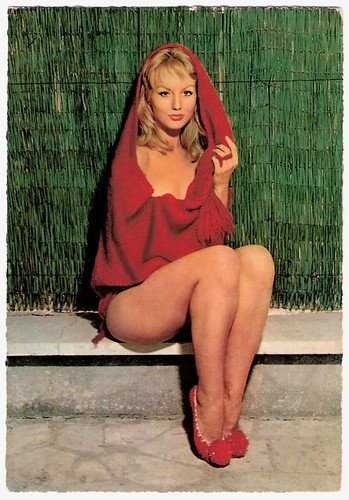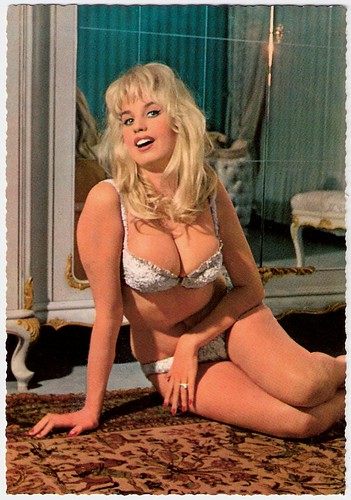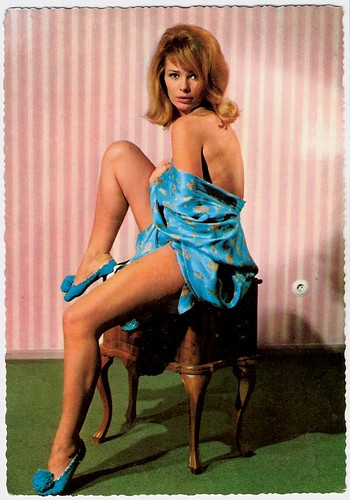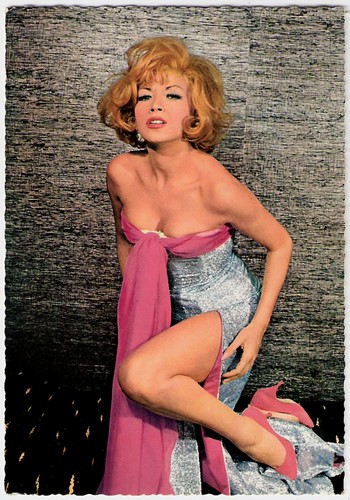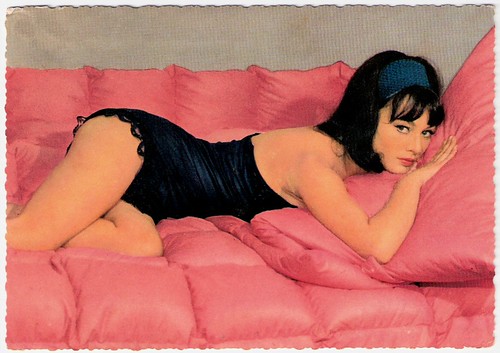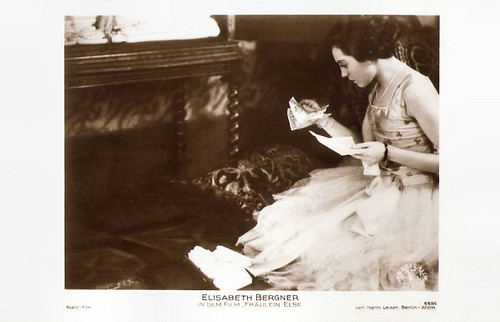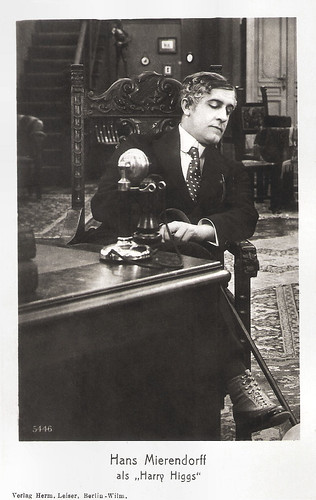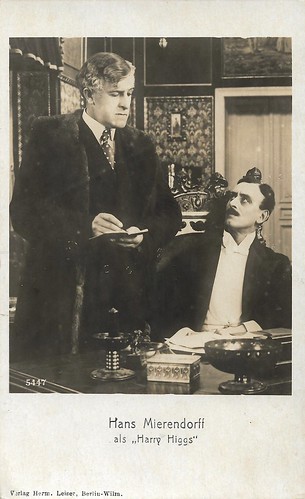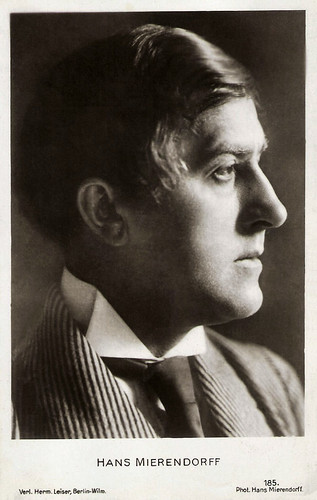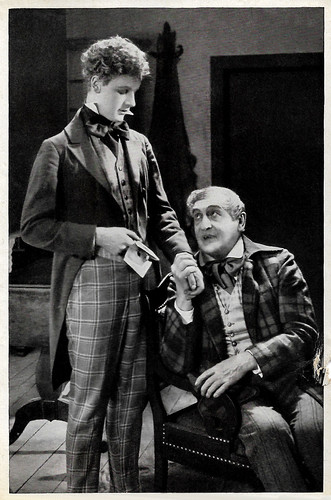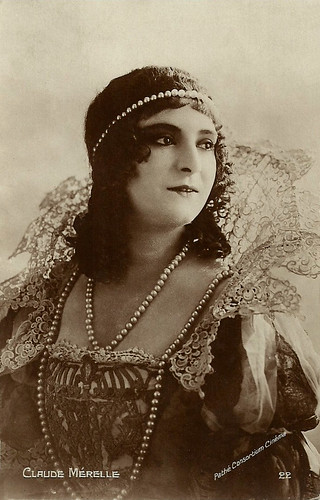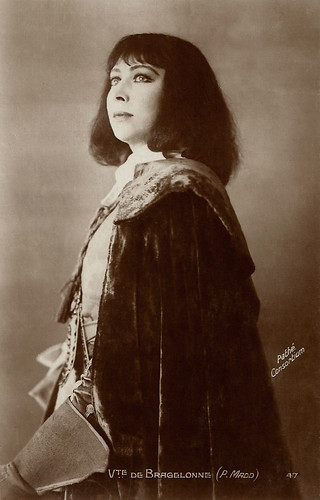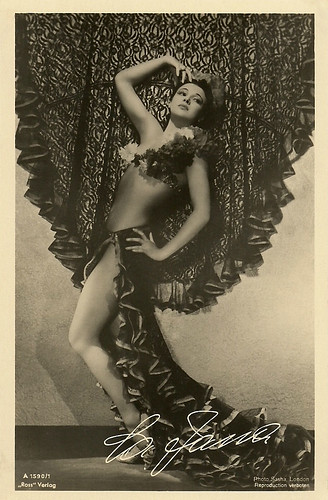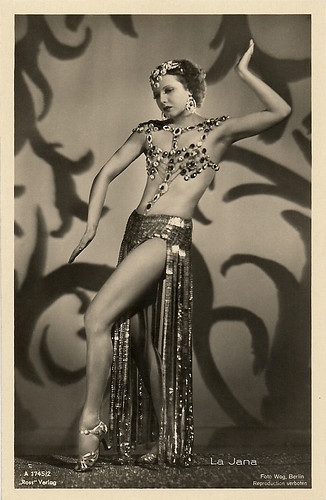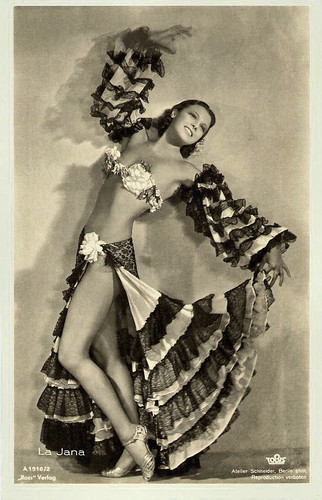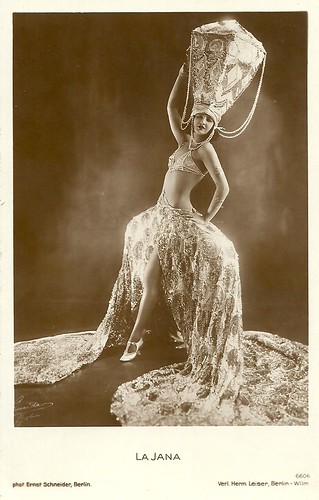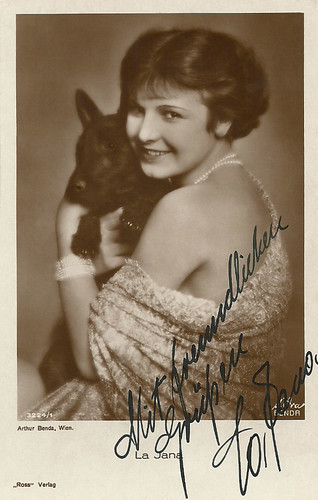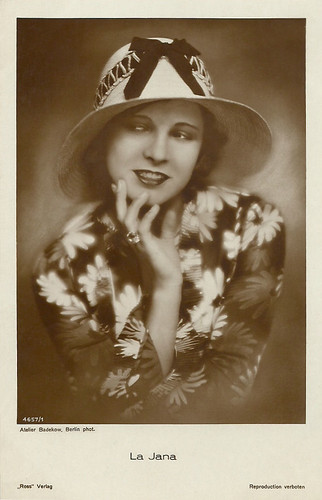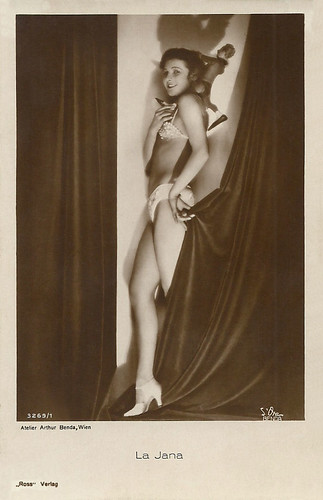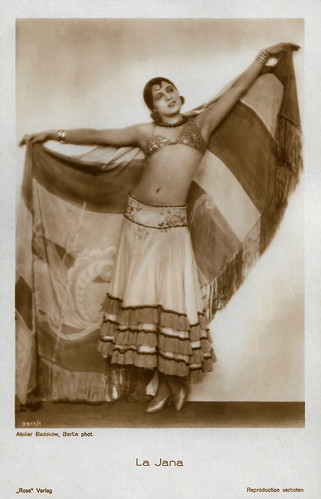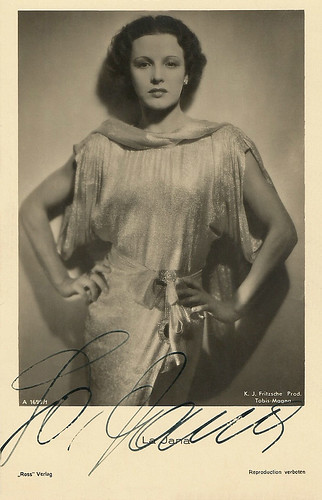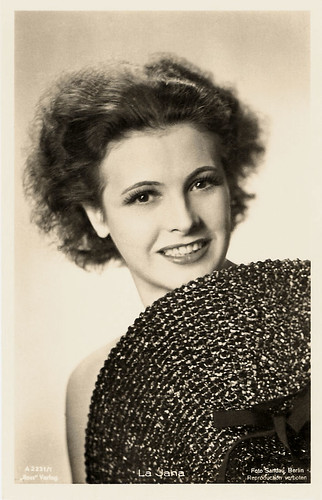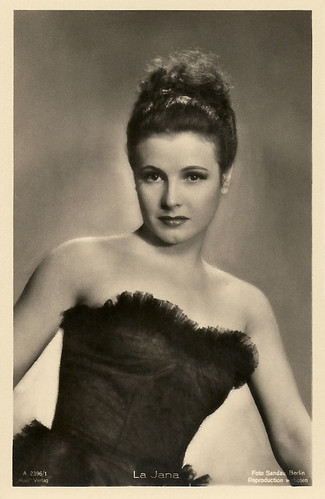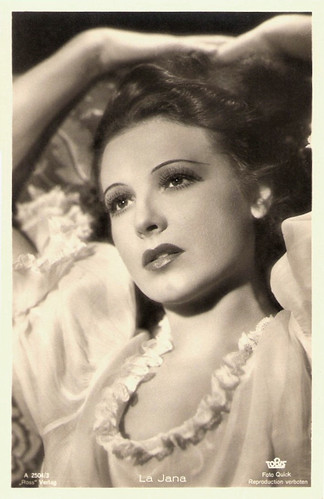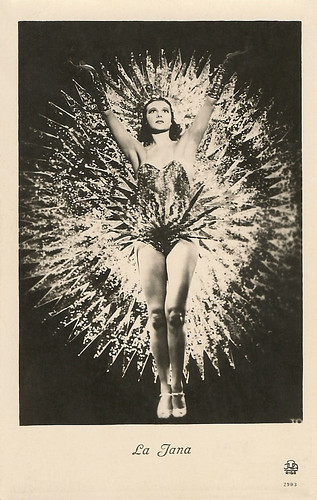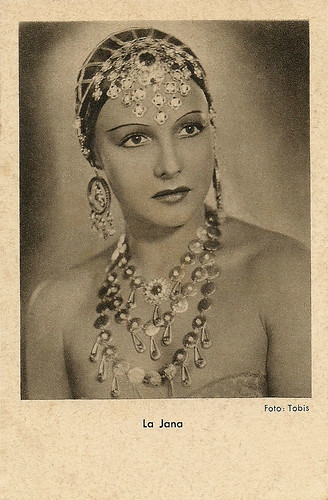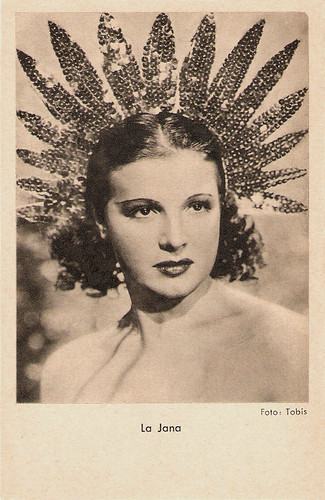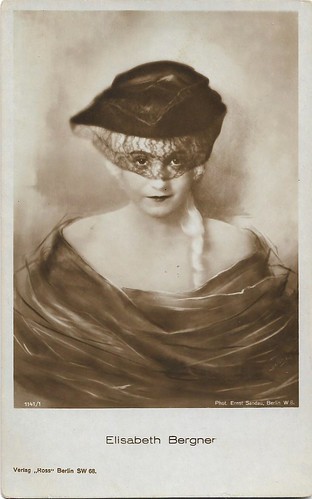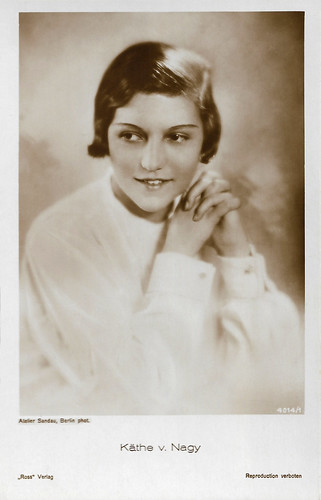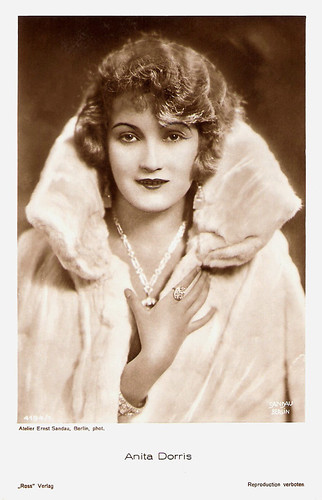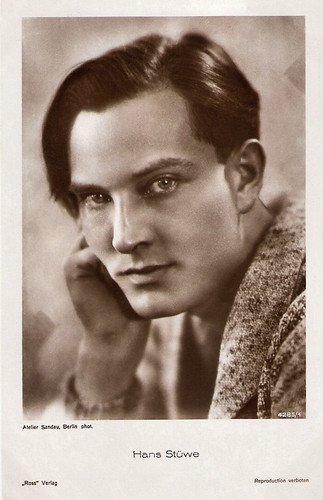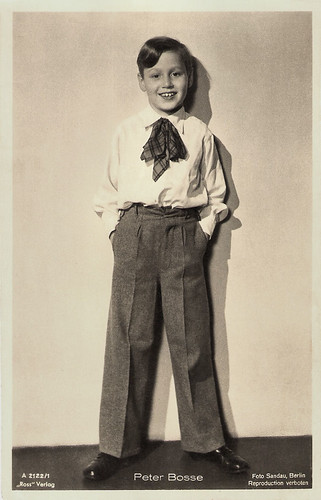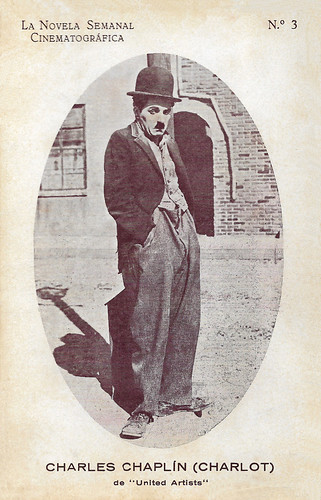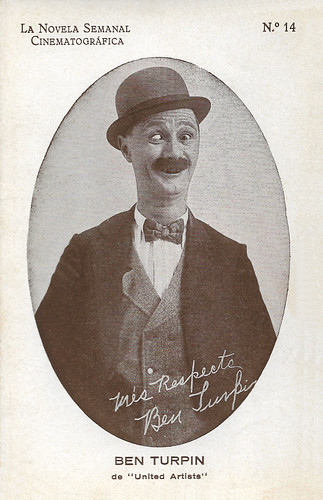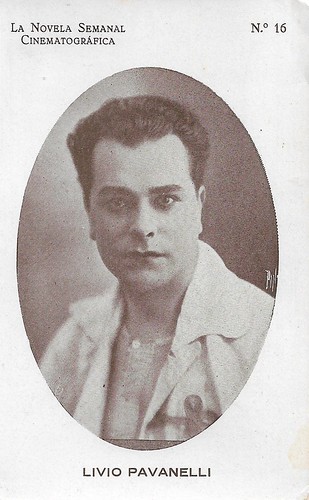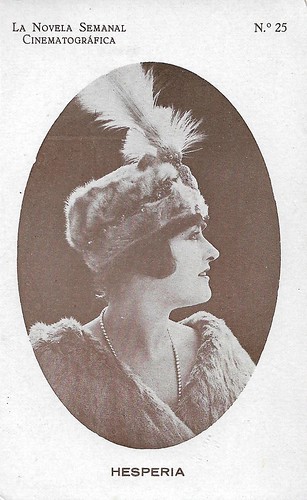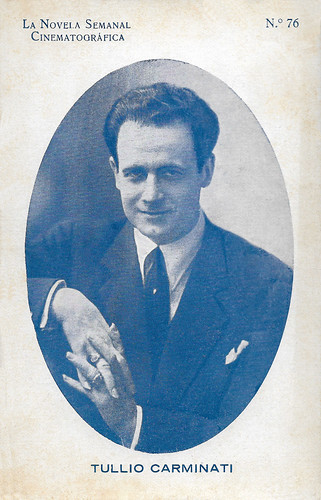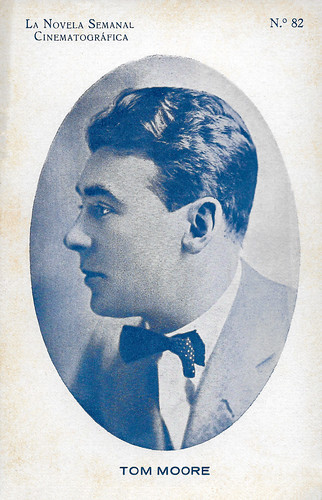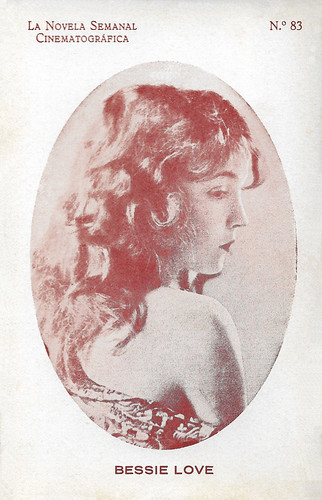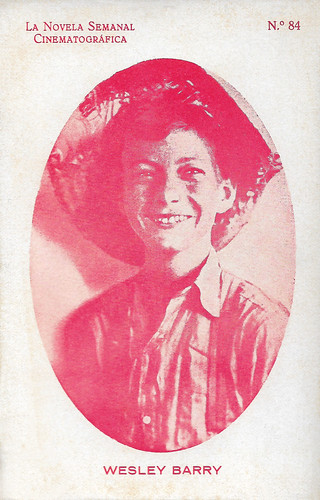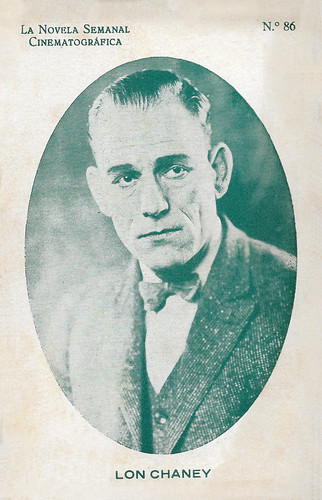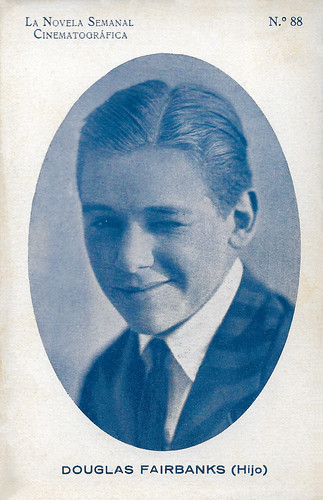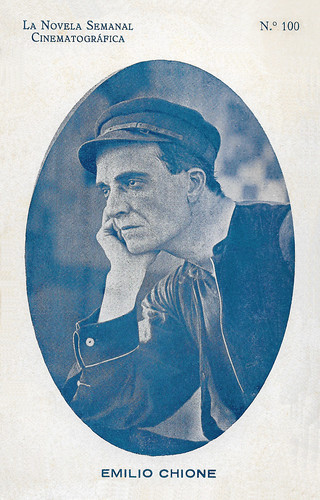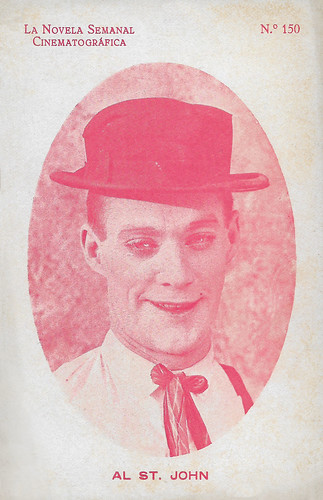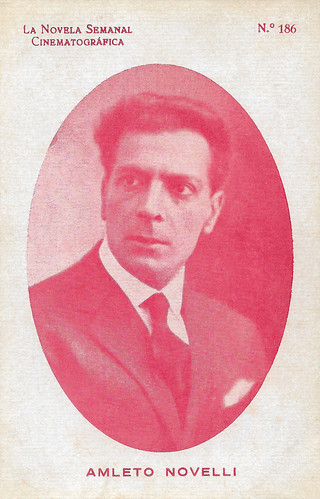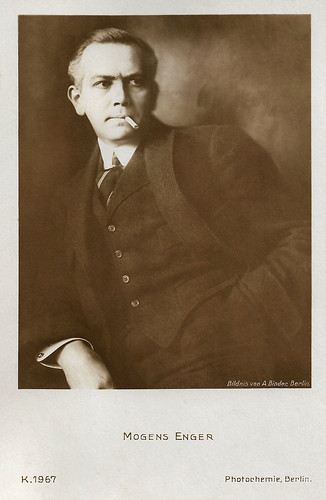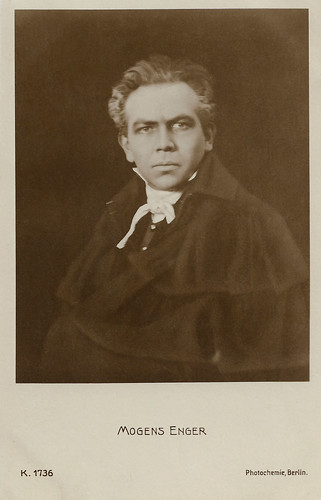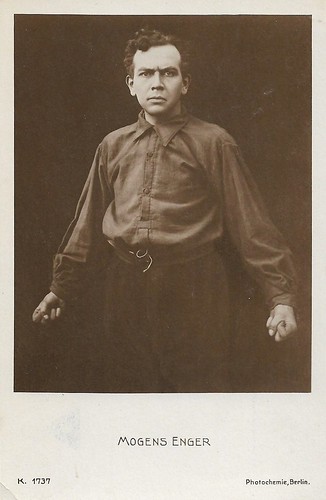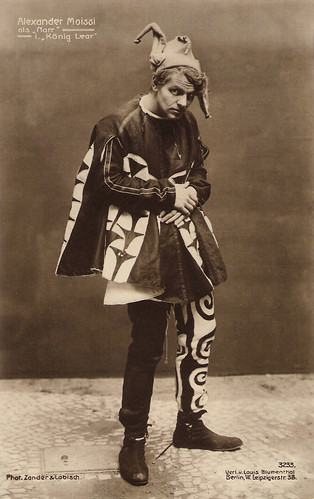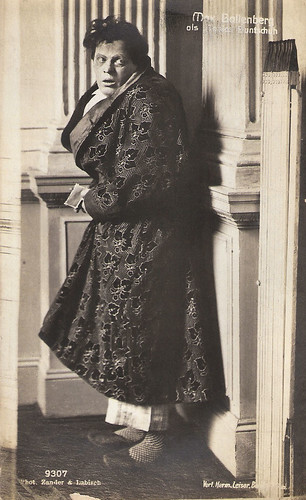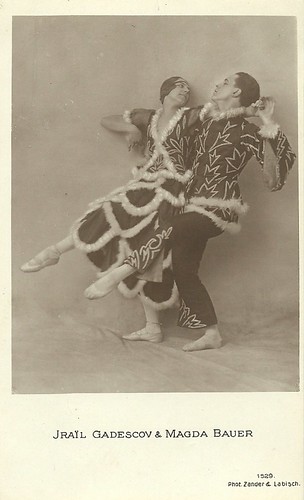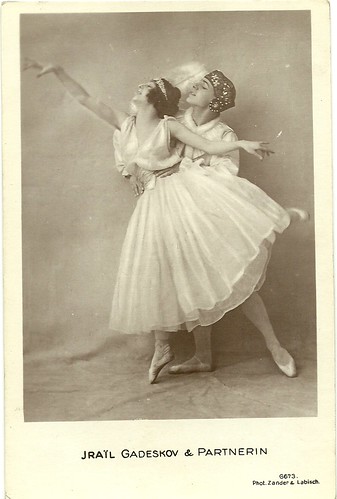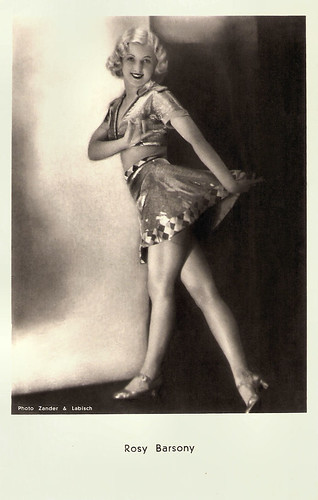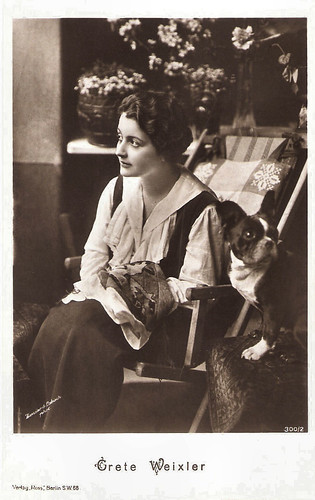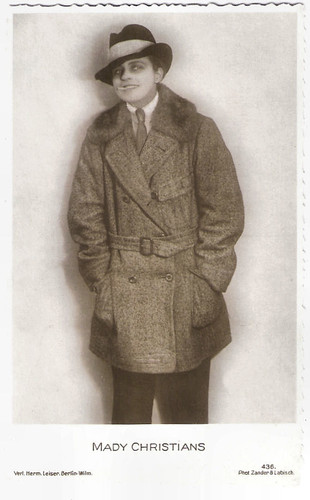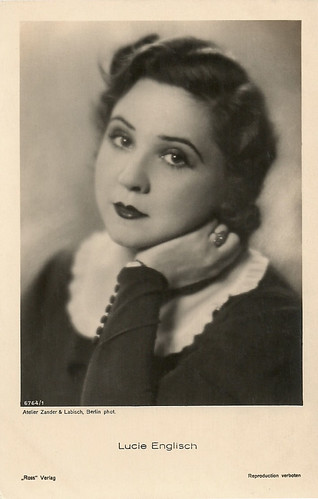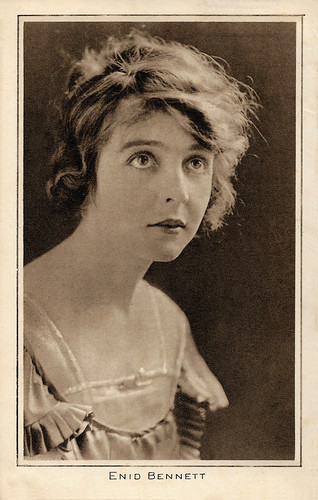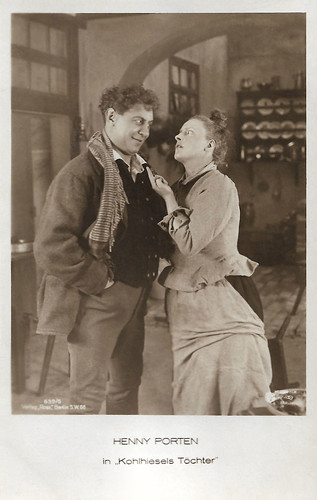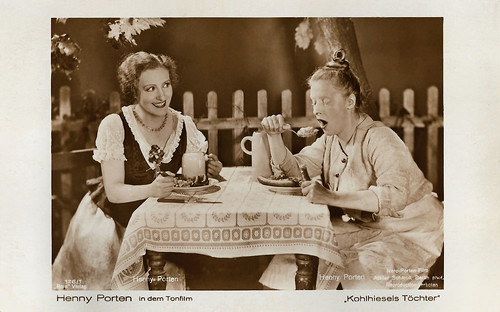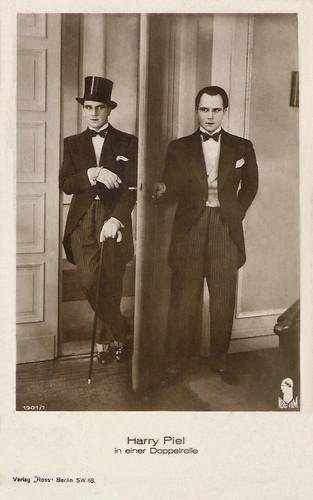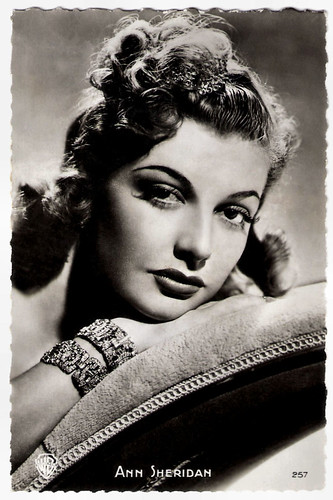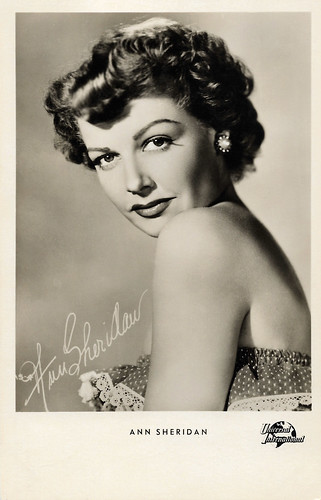Polish-born, German actress Dina Gralla (1905-1994) started as a naive, sexy dancer in German revues. The amiable brunette then was the leading lady in more than 35 silent and early sound films of the Weimar cinema. Tuberculosis ended her career in 1934.
![Dina Gralla]()
Austrian postcard by Iris-Verlag, no. 5069. Photo: Manassé, Wien.
![Dina Gralla]()
Austrian postcard by Iris-Verlag, no. 5070. Photo: Manassé, Wien.
![Dina Gralla]()
German postcard by Ross Verlag, no. 1208/1, 1927-1928. Photo: Alex Binder / Eichberg-Film, Berlin. Collection: Didier Hanson.
![Dina Gralla]()
German postcard by Ross Verlag, no. 6345/1, 1931-1932. Photo: Heros.
Dina Gralla was born as Dina Sventen in Warsaw, Poland (then part of the Russian Empire) in 1905.
She had a dance training in 1919 and performed as a ballet dancer at the revue of the Wintergarten theatre in Berlin. After some private acting lessons from Walter Steinbeck, she appeared in the film drama Leidenschaft/Passion (Richard Eichberg, 1925).
From then on she was seen regularly in German silent films in roles as a naive, sexy girl, often appearing with Lilian Harvey, like in Die Kleine vom Bummel/The Girl on the Road (Richard Eichberg, 1925) and Prinzessin Trulala/Princess Trulala (Erich Schönfelder, Richard Eichberg, 1926).
Repeatedly she played dancers, most famously in the leading part of the hit revue film Das Girl von der Revue/The Girl from the Revue (Richard Eichberg, 1928) with Werner Fuetterer. She also worked as a stage actress, for example at the Theater in der Behrenstraße.
Other films included Die Tolle Komtess/The Crazy Countess (Richard Löwenbein, 1928) with Max Ehrlich and Werner Fuetterer, Ein Kleiner Vorschuß auf die Seligkeit/A Small Down Payment on Bliss (Jaap Speyer, 1929) opposite Paul Hörbiger, Wer wird denn weinen, wenn man auseinandergeht?/No Use Crying If Your Sweetheart Goes Away (Richard Eichberg, 1929) with Paul Morgan.
![Werner Fuetterer and Dina Gralla in Das Girl von der Revue (1928)]()
Austrian postcard by Iris-Verlag, no. 5363. Photo: Hugo Engel-Film. Publicity still for Das Girl von der Revue (Richard Eichberg, 1928) with Werner Fuetterer.
![Dina Gralla and Harry Halm in Prinzessin Trulala (1926)]()
Polish postcard by Polonia, Krakow, no. 1320. Dina Gralla and Harry Halm in Prinzessin Trulala/Princess Trulala (Erich Schönfelder, Richard Eichberg, 1926).
![Dina Gralla in Du sollst nicht stehlen (1928)]()
German postcard by Ross Verlag, no. 3003/1, 1928-1929. Photo: Eichberg-Film, Berlin / Ufa. Dina Gralla in Du sollst nicht stehlen/Thou Shalt Not Steal (Victor Janson, 1928).
![Dina Gralla]()
German postcard by Ross Verlag, no. 4550/1, 1929-1930. Photo: Alex Binder, Berlin.
Despite her Polish accent, Dina Gralla could continue her film career into the sound era.
She appeared in such comedies as Keine Feier ohne Meyer/No Celebration Without Meyer (Carl Boese, 1931) with Sig Arno, Der Liebesarzt/Doctor Love (Erich Schönfelder, 1931) opposite Harry Liedtke, and Der Liebesexpreß/Eight Days of Happiness (Robert Wiene, 1931) with Georg Alexander.
Her later films included Schwebende Jungfrau/The Soaring Maiden (Carl Boese, 1931) with Lissi Arna and Szöke Szakall, and Ein Auto und kein Geld/A Car and No Money (Jacob Fleck, Luise Fleck, 1932) with Paul Kemp.
Tragically, in 1933 tuberculosis developed in her lungs, and she had to retire. Her final role was in Grüß' mir die Lore noch einmal/Say Hello to Lore for me one more time (Carl Heinz Wolff, 1934).
In the following decade, she worked as a stenotypist, and after 1945 as a cleaning lady and a waitress. Finally, she worked at a Berlin library. Gralla returned one last time for the cameras in the revue film An jedem Finger zehn/Ten on Every Finger (Erik Ode, 1954).
Dina Gralla died in 1994, in Berlin-Charlottenburg. She was 89. In 1926, she had married newspaper correspondent Lincoln Eyre.
![Dina Gralla in Das Girl von der Revue (1928)]()
German collectors card by Ross Verlag in the series Vom Werden deutscher Filmkunst - Der Stumme Film, picture no. 184, group 43. Photo: Ufa. Dina Gralla in Das Girl von der Revue/The Girl from the Revue (Richard Eichberg, 1928).
![Dina Gralla]()
German postcard by Ross Verlag, no. 4028/1, 1929-1930. Photo: Atelier Kiesel, Berlin.
![Dina Gralla]()
German postcard by Ross Verlag, no. 4163/1, 1929-1930. Photo: Ufa.
![Dina Gralla]()
Austrian postcard by Iris-Verlag, no. 6071. Photo: Max Wirstchafter & Co.
Sources: Filmportal.de, Wikipedia, and IMDb.

Austrian postcard by Iris-Verlag, no. 5069. Photo: Manassé, Wien.

Austrian postcard by Iris-Verlag, no. 5070. Photo: Manassé, Wien.

German postcard by Ross Verlag, no. 1208/1, 1927-1928. Photo: Alex Binder / Eichberg-Film, Berlin. Collection: Didier Hanson.

German postcard by Ross Verlag, no. 6345/1, 1931-1932. Photo: Heros.
Naive and Sexy
Dina Gralla was born as Dina Sventen in Warsaw, Poland (then part of the Russian Empire) in 1905.
She had a dance training in 1919 and performed as a ballet dancer at the revue of the Wintergarten theatre in Berlin. After some private acting lessons from Walter Steinbeck, she appeared in the film drama Leidenschaft/Passion (Richard Eichberg, 1925).
From then on she was seen regularly in German silent films in roles as a naive, sexy girl, often appearing with Lilian Harvey, like in Die Kleine vom Bummel/The Girl on the Road (Richard Eichberg, 1925) and Prinzessin Trulala/Princess Trulala (Erich Schönfelder, Richard Eichberg, 1926).
Repeatedly she played dancers, most famously in the leading part of the hit revue film Das Girl von der Revue/The Girl from the Revue (Richard Eichberg, 1928) with Werner Fuetterer. She also worked as a stage actress, for example at the Theater in der Behrenstraße.
Other films included Die Tolle Komtess/The Crazy Countess (Richard Löwenbein, 1928) with Max Ehrlich and Werner Fuetterer, Ein Kleiner Vorschuß auf die Seligkeit/A Small Down Payment on Bliss (Jaap Speyer, 1929) opposite Paul Hörbiger, Wer wird denn weinen, wenn man auseinandergeht?/No Use Crying If Your Sweetheart Goes Away (Richard Eichberg, 1929) with Paul Morgan.

Austrian postcard by Iris-Verlag, no. 5363. Photo: Hugo Engel-Film. Publicity still for Das Girl von der Revue (Richard Eichberg, 1928) with Werner Fuetterer.

Polish postcard by Polonia, Krakow, no. 1320. Dina Gralla and Harry Halm in Prinzessin Trulala/Princess Trulala (Erich Schönfelder, Richard Eichberg, 1926).

German postcard by Ross Verlag, no. 3003/1, 1928-1929. Photo: Eichberg-Film, Berlin / Ufa. Dina Gralla in Du sollst nicht stehlen/Thou Shalt Not Steal (Victor Janson, 1928).

German postcard by Ross Verlag, no. 4550/1, 1929-1930. Photo: Alex Binder, Berlin.
Tuberculosis
Despite her Polish accent, Dina Gralla could continue her film career into the sound era.
She appeared in such comedies as Keine Feier ohne Meyer/No Celebration Without Meyer (Carl Boese, 1931) with Sig Arno, Der Liebesarzt/Doctor Love (Erich Schönfelder, 1931) opposite Harry Liedtke, and Der Liebesexpreß/Eight Days of Happiness (Robert Wiene, 1931) with Georg Alexander.
Her later films included Schwebende Jungfrau/The Soaring Maiden (Carl Boese, 1931) with Lissi Arna and Szöke Szakall, and Ein Auto und kein Geld/A Car and No Money (Jacob Fleck, Luise Fleck, 1932) with Paul Kemp.
Tragically, in 1933 tuberculosis developed in her lungs, and she had to retire. Her final role was in Grüß' mir die Lore noch einmal/Say Hello to Lore for me one more time (Carl Heinz Wolff, 1934).
In the following decade, she worked as a stenotypist, and after 1945 as a cleaning lady and a waitress. Finally, she worked at a Berlin library. Gralla returned one last time for the cameras in the revue film An jedem Finger zehn/Ten on Every Finger (Erik Ode, 1954).
Dina Gralla died in 1994, in Berlin-Charlottenburg. She was 89. In 1926, she had married newspaper correspondent Lincoln Eyre.

German collectors card by Ross Verlag in the series Vom Werden deutscher Filmkunst - Der Stumme Film, picture no. 184, group 43. Photo: Ufa. Dina Gralla in Das Girl von der Revue/The Girl from the Revue (Richard Eichberg, 1928).

German postcard by Ross Verlag, no. 4028/1, 1929-1930. Photo: Atelier Kiesel, Berlin.

German postcard by Ross Verlag, no. 4163/1, 1929-1930. Photo: Ufa.

Austrian postcard by Iris-Verlag, no. 6071. Photo: Max Wirstchafter & Co.
Sources: Filmportal.de, Wikipedia, and IMDb.
